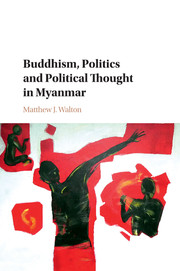Book contents
- Frontmatter
- Dedication
- Contents
- Acknowledgments
- A Note on Language and Usage
- Introduction
- 1 A Brief Political History and Cast of Characters
- 2 Building Blocks of a Moral Universe
- 3 On Human Nature and the Nature of Politics
- 4 Order and Freedom/Liberation: Purposes of Politics
- 5 What is “Politics” and What Constitutes “Participation”?
- 6 Discipline, Rights, and Morality: “Democracy” in Contemporary Myanmar
- Conclusion
- Appendix Glossary of Burmese and Buddhist Terms
- Bibliography
- Index
Introduction
Published online by Cambridge University Press: 22 December 2016
- Frontmatter
- Dedication
- Contents
- Acknowledgments
- A Note on Language and Usage
- Introduction
- 1 A Brief Political History and Cast of Characters
- 2 Building Blocks of a Moral Universe
- 3 On Human Nature and the Nature of Politics
- 4 Order and Freedom/Liberation: Purposes of Politics
- 5 What is “Politics” and What Constitutes “Participation”?
- 6 Discipline, Rights, and Morality: “Democracy” in Contemporary Myanmar
- Conclusion
- Appendix Glossary of Burmese and Buddhist Terms
- Bibliography
- Index
Summary
On September 24, 2007, tens of thousands of Buddhist monks marched down the main thoroughfares of Yangon, a sea of dark maroon robes creating the lasting image of what the media would deem the “Saffron Revolution,” after the color commonly associated with monks’ robes in the country. This was the sixth day of monastic demonstrations in downtown Yangon, the culmination of a wave of dissent that had begun with citizen protests against the removal of fuel subsidies the month before and had escalated after reports that the Burmese military had violently subdued monks demonstrating in the northern city of Pakokku earlier in September. Beginning on September 18, the ranks of the monks had swelled each day and similar actions were taking place in urban areas across the country. This day they marched along with tens of thousands of lay people, although the monks had initially asked the laity not to join the demonstrations. Gradually, however, lay people did join, linking hands to create protective barriers around the monks as they marched and raising the banners of opposition groups, including the National League for Democracy (NLD) and even the long-outlawed student union.
While some monks began the march each afternoon at their home monasteries, eventually converging on Sule Pagoda in downtown Yangon, growing numbers gathered at the foot of the iconic golden dome of the Shwedagon Pagoda, a mile or so north of the city center. These monks met to chant protective prayers before marching, but the significance of the location was not lost on any Burmese observers. In addition to being the most revered Buddhist site in the country (strands of the Buddha's hair are allegedly buried beneath it), it has also been a focal point of political activity since the colonial period. The martyred leader of the independence movement, General Aung San, gave speeches in front of the pagoda in the 1940s and over forty years later, his daughter, Daw Aung San Suu Kyi, invigorated the democracy movement of 1988 with a speech in the same location. The rhetoric and protest repertoire of the monks in 2007 perfectly mirrored the Shwedagon Pagoda's combination of religious and political symbolism.
- Type
- Chapter
- Information
- Buddhism, Politics and Political Thought in Myanmar , pp. 1 - 21Publisher: Cambridge University PressPrint publication year: 2016



